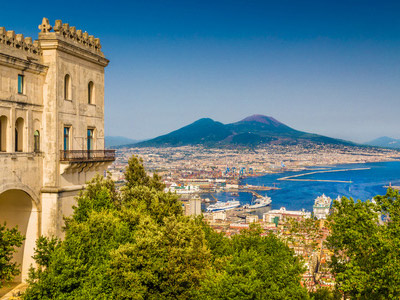NAPLES
NAPLES
Naples is incomparable. The distinctive silhouette of Vesuvius makes its gulf unique. Very few volcanoes look more like the ones in your imagination than Vesuvius. But this is not the only feature that makes Naples surprisingly recognizable. The fortresses, castles, and royal palaces that clearly mark a noble past mingle with the suburbs that climb the sides of the volcano to the noisy and colorful working-class neighborhoods of the center.
Over the centuries Naples was ruled by many European families. You will see some of them represented by statues on the facade of the Royal Palace: Charles V of the Hapsburgs, Charles III of the Bourbons, Joseph Murat of the Bonaparte family, and finally Victor Emmanuel II of the House of Savoy who became King of Italy in 1861. Unfortunately, with the Italian capital moving to Turin, then Florence and finally Rome, Naples lost much of its importance. A civic decline set in during the 19th century, and the city has yet to recover. The historic center still has too many boarded-up buildings.
The city is home to architectural wonders such as - the Principe di Napoli and Umberto II Galleries, royal palaces, churches and former convents The port of Naples serves as a gateway to major destinations - Pompeii, Sorrento, Ravello, Positano, Capri, and Ischia - but it is also a city to be enjoyed on its own.
